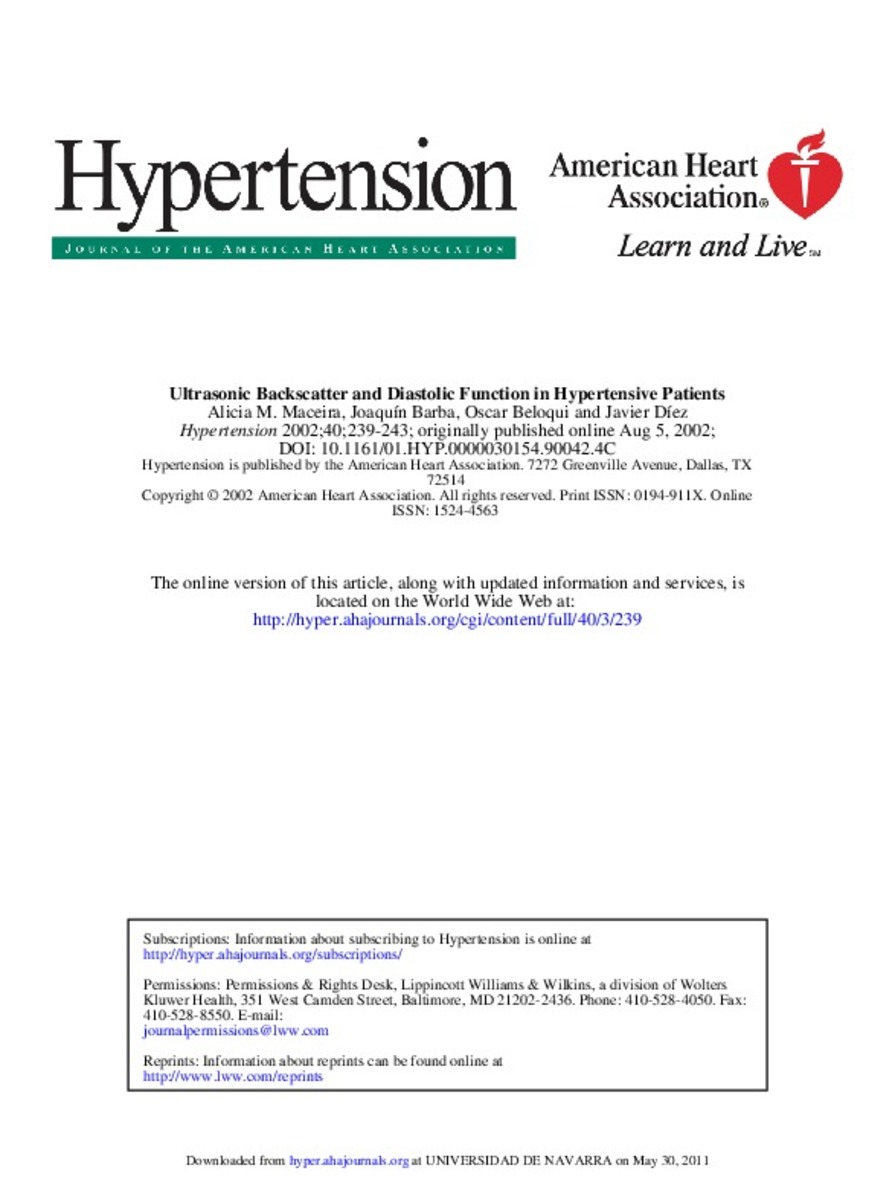Full metadata record
| DC Field | Value | Language |
|---|---|---|
| dc.creator | Maceira, A.M. (Alicia M.) | |
| dc.creator | Barba, J. (Joaquín) | |
| dc.creator | Beloqui, O. (Óscar) | |
| dc.creator | Diez-Martinez, J. (Javier) | |
| dc.date.accessioned | 2011-11-23T09:49:28Z | - |
| dc.date.available | 2011-11-23T09:49:28Z | - |
| dc.date.issued | 2002 | - |
| dc.identifier.citation | Maceira AM, Barba J, Beloqui O, Diez J. Ultrasonic backscatter and diastolic function in hypertensive patients. Hypertension 2002 Sep;40(3):239-243. | es_ES |
| dc.identifier.issn | 0194-911X | - |
| dc.identifier.uri | https://hdl.handle.net/10171/19907 | - |
| dc.description.abstract | This study was designed to assess whether ultrasonic reflectivity, evaluated by a real-time integrated backscatter analysis, was related to the severity of diastolic dysfunction, as studied by Doppler echocardiography in patients with essential hypertension. One hundred nine subjects were included in the study. Diastolic function was assessed by mitral-inflow Doppler ultrasound recordings. Backscatter cyclic variation and maximal intensity were measured in 6 regions throughout the left ventricle. The subjects were classified in 5 groups according to blood pressure and diastolic function: 29 normotensives with normal diastolic function (group 1), 18 hypertensives with normal diastolic function (group 2), 47 hypertensives with a delayed relaxation pattern (group 3), 11 hypertensives with a pseudonormal filling pattern (group 4), and 4 hypertensives with a restrictive filling pattern (group 5). The highest cyclic variation was found in groups 1 and 2, the lowest in groups 4 and 5 (5.7+/-0.2 dB in group 1 and 5.7+/-0.2 dB in group 2 versus 2.9+/-0.3 dB in group 4 and 2.1+/-0.4 dB in group 5; P<0.001), with intermediate values in group 3 (5.2+/-0.2 dB). Cyclic variation was inversely correlated with left ventricular chamber stiffness (P<0.05) and directly correlated with midwall fractional shortening (P<0.02) in all hypertensives. No differences in maximal intensity were found among the 5 groups of subjects. These results show an association between diminished cyclic variation of backscatter and deterioration of diastolic function in hypertensive patients. Thus, alterations in this parameter may be useful for the assessment of diastolic dysfunction in hypertension. | es_ES |
| dc.language.iso | eng | es_ES |
| dc.publisher | American Heart Association | es_ES |
| dc.rights | info:eu-repo/semantics/openAccess | es_ES |
| dc.subject | Diastole | es_ES |
| dc.subject | Hypertension, essential | es_ES |
| dc.subject | Ultrasonography | es_ES |
| dc.title | Ultrasonic backscatter and diastolic function in hypertensive patients | es_ES |
| dc.type | info:eu-repo/semantics/article | es_ES |
| dc.identifier.doi | http://dx.doi.org/10.1161/01.HYP.0000030154.90042.4C | es_ES |
Files in This Item:
Statistics and impact
Items in Dadun are protected by copyright, with all rights reserved, unless otherwise indicated.






